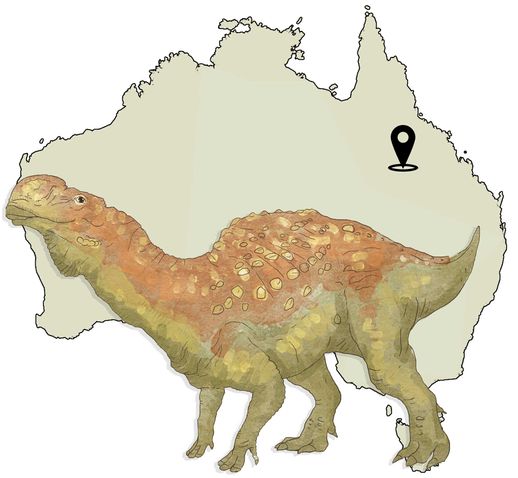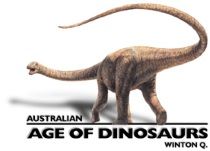Muttaburrasaurus langdoni

Mutt-ah-burra-sore-us lang-don-eye
Meaning
[Doug] Langdon’s Muttaburra lizard
Period
Early Cretaceous (103–101 Mya)
Discovery and publication
Found on Roseberry Downs Station near Muttaburra, Queensland, in 1963 by grazier Doug Langdon. Specimens were collected by many locals but were returned at the request of Dr Alan Bartholomai (and Muttaburra police). Langdon’s dinosaur specimen was named and described by Dr Ralph Molnar and Dr Alan Bartholomai in 1981. The specimens are held at the Queensland Museum. Other specimens of Muttaburrasaurus, one of which includes a skull, have since been found near Richmond and Hughenden (with similar teeth also reported from Lightning Ridge), and several of these are also held at the Queensland Museum.
Description
When found in 1963, Muttaburrasaurus became the most complete dinosaur ever found in Australia (although this title has since passed to the ankylosaur Kunbarrasaurus, formerly known as Minmi sp., discovered near Richmond in 1989). It was the first dinosaur in Australia to be cast and mounted, and replica skeletons can be seen in Brisbane, Hughenden, Melbourne, Sydney, Canberra, and Fukui (Japan).
Muttaburrasaurus was a medium-sized ornithopod (albeit much larger than all other known Australian ornithopods) which would have been equally capable of walking just on its back legs or on all fours. The most distinctive feature of Muttaburrasaurus is its snout, which bears a raised bump which, in life, might have housed a hollow chamber. The purpose of this chamber is unknown, although it is suspected that it either enhanced this herbivore’s sense of smell or amplified its voice.
Muttaburrasaurus was originally classified as an iguanodontid (due to superficial similarities to dinosaurs like Iguanodon), although more recent research has led to much debate over its place in the ornithopod family tree. Some researchers today place it in a group of ornithopods known as rhabdodontids, although the only other known members of this group lived in Europe during the Late Cretaceous. Others suggest that Muttaburrasaurus was somewhat more advanced than the rhabdodontids, and that it occupied a position on the ornithopod family tree intermediate between them and the long-tailed Tenontosaurus, and more advanced iguanodonts like the North American Camptosaurus, the sail-backed Ouranosaurus and the spike-thumbed Iguanodon.
The jaws of Muttaburrasaurus would have been capable of delivering powerful bites. The horny beak at the front of the mouth was used to snip and pluck at very tough plant material, whereas the grinding teeth behind (which were set within fleshy cheeks) were perfectly adapted for pulverising plant matter and easing digestion.
As mentioned above, Muttaburrasaurus was medium-sized by ornithopod standards, achieving a length of 7–8m and a height of 2.5m.
